|
|
Today team echinacea celebrated independence day with a picnic at the Elk Lake beach, The gathering started with the annual reading of the Declaration of Independence, and remembering why we celebrate on the Fourth of July. After the reading was complete the team had a potluck which included baked beans, lots of fruits and veggies and some really good iced tea! After eating and of course waiting 30 minutes some of the team swam and canoed. All in all a great picnic and the team is looking forward to having the day off tomorrow!
 Stuart starts off the reading of the Declaration!  The Feast!
Today we went out looking for pollen producing Echinacea heads, after finding one at East Elk Lake Road and in experimental plot 1. We started looking for flowers at Steven’s Approach and we found one that had started producing pollen today! After searching at Steven’s Approach some of us went out to scout other remnants for plants that had already begun flowering. We found 18 flowering plants! One at East Riley started flowering about 5 days ago! After visiting all of the remnants we took a break for lunch and heard about Lea and James’ independent projects.
 The team learns about recording data on flowering phenology and finding flowering plants!  First flowering plant at Steven’s Approach!  Amy and James tagging flowering Echinacea  Echinacea on day 5 of flowering at East Riley After lunch we headed down to experimental plot 1 to continue searching for stipa, we searched all the rows and found about 130 flowering plants. One of the plants had over 200 fruits! We ended our day measuring seedlings in q2.
Finding flowers this morning means we have to get on top of thoroughly searching the remnants for plants that will flower this summer so we can get flowering phenology and demography data from them. We have our work cut out for us!
Today was the first day of the field season. We met at the Hjelm house at 8:30 but quickly left for a tour of the largest prairie remnant that we will be working in, Staffanson Prairie Preserve. We got a lesson in the history of the landscape from Stuart. We learned about geologic features in western Minnesota that were formed by glaciers almost 10,000 years ago! We also learned about the role European settlement had on the size and composition of prairie communities. We had a good look at many of the earliest plants to flower at Staffanson. We also got to see how big of a difference a burn makes in the prairie since the west unit was burned this spring. As we were leaving Staffanson it began to rain and we had to cut our tour of the remnant prairies in Solemn Township short.
After lunch Stuart gave a talk about some of the work that has been done on the project since it started. He talked about the Echinacea angustifolia mating scene and how the different dimensions of reproduction affect plant fitness. Distance, timing and compatibility can all play a role in the reproductive success of Echinacea! Jennifer also gave a talk on her work with pollinators and Echinacea, we learned about how varying taxa of pollinator affects the quality and quantity of pollen that a plant will receive. Her talk gave us a lot of good information to build a foundation for the work that will be done this summer with pollinators!
We called it a day a little early because of the rainy weather and so we could do some reading and think about what we want our independent projects to be for the summer. Tomorrow looks like it will be a little bit nicer or at least it won’t rain so hopefully we will be able to visit a few remnants and get started measuring seedlings that are apart of the Q3 experiment!
 A dragonfly I spotted at Staffanson trying to warm up early in the morning, hopefully it didn’t get too beaten up by the rain!  Stuart is giving his talk about the 3 dimensions of the Echinacea mating scene!
Echinacea Project 2016
Ecology, Evolution and Behavior & Plant Biology, University of Minnesota – Twin Cities 2018
Research Interests
This will be my third summer with the Echinacea Project, in past years I have investigated methods for increasing pollen longevity and the heritability of flowering time and duration in Echinacea angustifolia. I am very interested in using quantitative genetic methods to investigate traits in long-lived perennials and learning how local adaptation affects prairie species and overall prairie health. This summer I am looking forward to working with the demography and surveying aspects of the project.
Statement
I am from Alexandria, MN about 20 miles from the research site. In my spare time I enjoy doing things outdoors; fly-fishing, biking, hiking and kayaking are a few of my favorites! I also enjoy taking photo’s of the plants that we encounter during our field work. I am very excited to be back with the project this summer and I can’t wait to get started

Today when we arrived at the Hjelm house it was only 50 degrees! Brrrrrr! We were also down to a team of six following Ben’s last day on Friday and Stuart and Gretel heading back to Illinois over the weekend. (Abby was gone for her senior pictures). With so few people we got off to a quick start, because we knew we would need all the time we could get to get as much done with fewer crew members.
Our skeleton crew headed out to p2 to continue measuring that we started last Thursday. It was slow going but, having gotten through the thickest of the flowering plants on Thursday it was faster than it could have been. It is always windy at p2 since it is on top of a hill but today was especially windy and cold, most crew members could barely feel their hands which made entering data on the visor a challenge. We managed to get by, completing 20 rows before heading in for lunch.
After a warm up with some hot chocolate at lunch we headed out to do various things in the afternoon. Danny, Amy, Gina and I went to harvest heads in the remnants based on a sampling method that Danny and Amy developed. Ali and Katherine rechecked some funky measurements in p1 and harvested a few of the heads that will be used in the q3 experiment (exciting!). Amy and I went to a ton of different remnants and encountered a few problems, like at Stevens approach were most of the heads were mowed. The highlight of our afternoon was at Aanenson where we met a really friendly cow named Willow! she came up to the fence and let us pet her. Her not-so-outgoing friends were hesitant and we didn’t pet them. Willow even gave Amy’s hand a lick, “it felt really weird” said Amy shortly after the licking. Sadly we could not spend all afternoon with our new friend and went to continue harvesting.
 Willow the cow investigates her new, soon-to-be friends, Will and Amy  Willow’s friends investigate us from afar, clearly not as outgoing or cool as Willow.
Rainy weather covered the research area this morning, so the team worked on their independent projects, entering data, working on plant identification, web resources, and learning R! At 11 Stuart gave us all a lesson in statistics, that involved analyzing Taylor’s data using a linear model and an ANOVA test. The analysis gave some interesting results!
After lunch the whole team headed out to P2 at Hegg lake to pull thistles. We pulled hundreds of thistles, maybe even thousands.
 Abby, Ali, and Amy pull thistles in p2  Katherine in pain as she holds a bundle of thistles waiting for me to take a picture After an hour or two storm clouds started to roll in over Kensington, headed in our direction. We decided to call it a day before we got to wet.
 Storm Clouds headed towards us
Today was our day off, and I decided to spend the day on the lake. I took out my kayak and fishing pole and spent the afternoon paddling around on Union Lake, which is located just south of Alexandria. I saw a loon family swimming around the lake, earlier this spring there were two chicks, unfortunately there was only one today. 
Even though today was relaxing and fun I will be glad to get back to work tomorrow! There is a lot to do before flowering starts ramping up.
After our day was delayed by rain, we started off the morning with remnant phenology. Groups headed to the landfill site, Staffanson Prairie Preserve and other remnants. We shot several points at Landfill, East Elk Lake Road and Around Landfill. We got a lot done in the morning!
We had a late lunch and then headed back out into the field. Three of us went to Hegg Lake and put twist ties on flowering plants in Jennifer’s plot. there is a ton of flowers out there and we are almost a quarter of the way done! I will be doing a project involving the plants in Jennifer’s plot (p2) looking at the heritability of flowering phenology in Echinacea angustifolia. It is great to have a lot of flowers in p2!

Here is Ben after twist tying about 70 flowering Echinacea heads in p2, Thanks for the help Ben!
The Riley remnant is composed of two halves, one north of mellow lane and the other south. The two halves are quite a bit different for being separated by only a few meters. The northern half falls on the side of a hill that was most likely never plowed. The hillside is filled with the non-native Kentucky Blue Grass, with a few patches of another non-native: Brome. The most abundant flower was the wild rose, and amongst the grasses many soon to be flowering Purple coneflowers were apparent. Moving across the road to the southern half the dominant grass becomes Brome. There is wild rose here but not as much. There are a few tall grasses; the dead stalks from last year are visible. There is a path through the middle that is often driven over to get to an agricultural field about 100 meters south of the remnant. This southern half was probably scraped and used to create the road that now divides the remnant. There are several Purple coneflowers in the ditch surrounded by invasive sweet clover which has a tall yellow flower and is the most abundant flower in this half. From these first few minutes spent at the riley remnant it is evident that this site will soon be filled with Echinacea flowers. What a wonderful sight to see!

Today we spent the morning doing remnant phenology. It seems that we are getting to the end of flowering and phenology is going faster and faster. During phenology we collected pollen that will be freeze dried and used for crosses next summer! Woah! While I was collecting pollen from the single flowering plant at the DOG site, the elusive three legged dog came to visit me. She fell down by me and panted while I collected the pollen. 
In the afternoon we furiously measured Experimental Plot 1. Gretel and I raced other groups aswell as each other, finishing four rows before we called it a day and headed in.
|
|



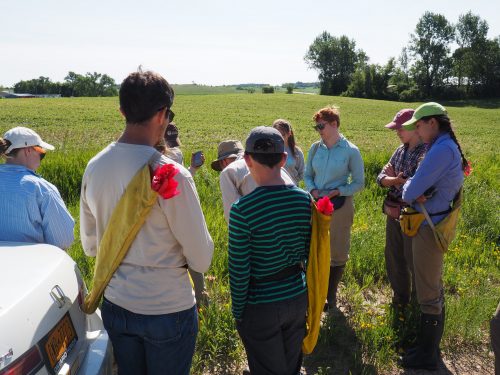
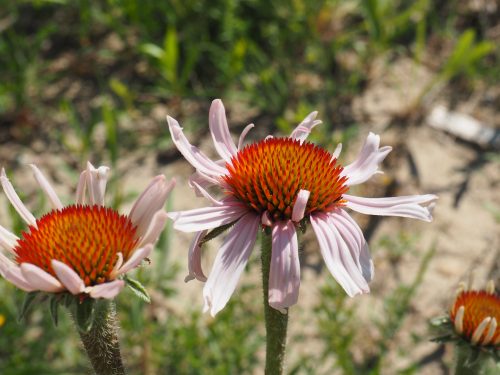
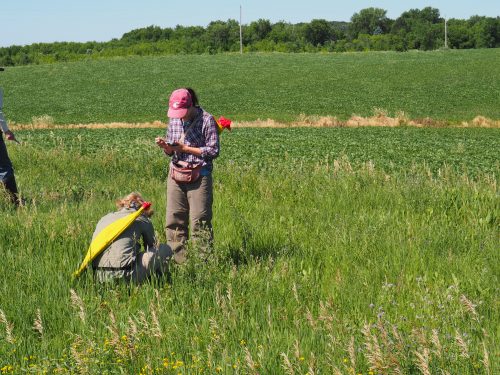
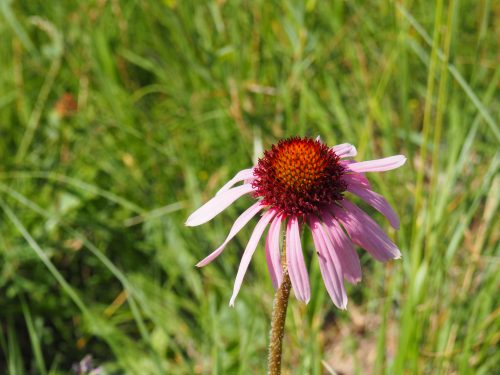





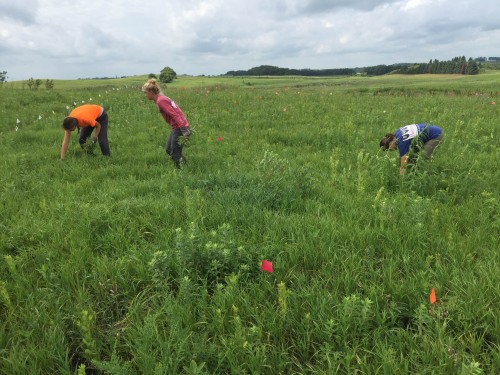

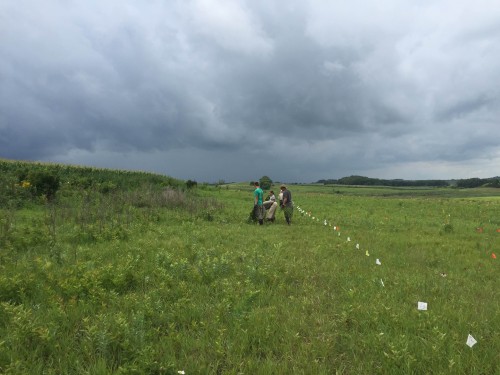

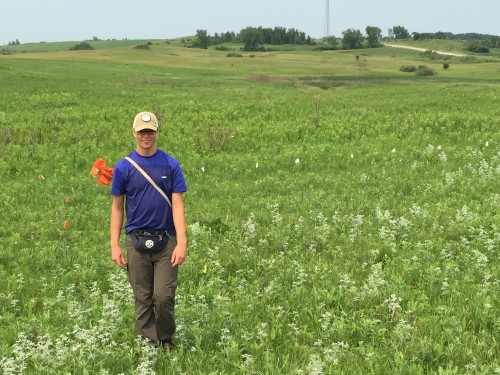

-thumb-260x195-194150.jpg)